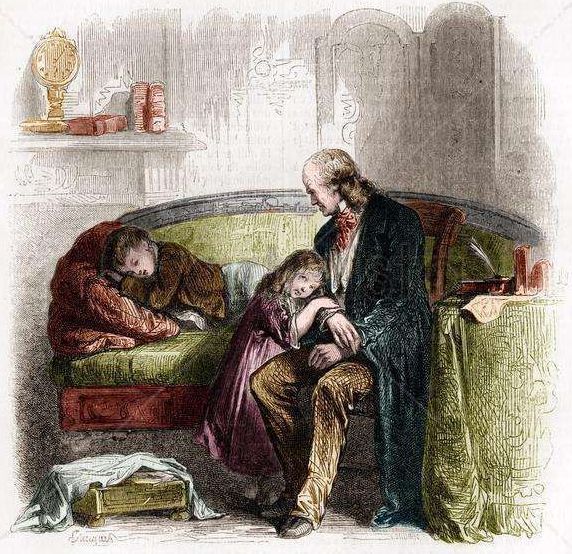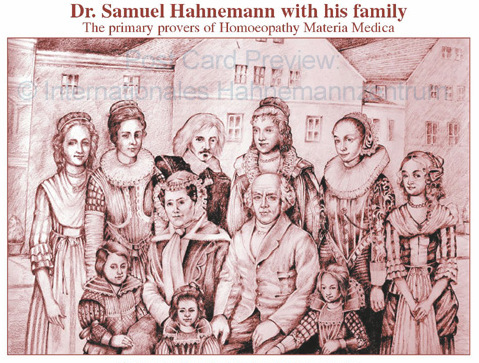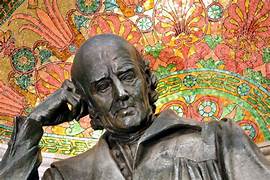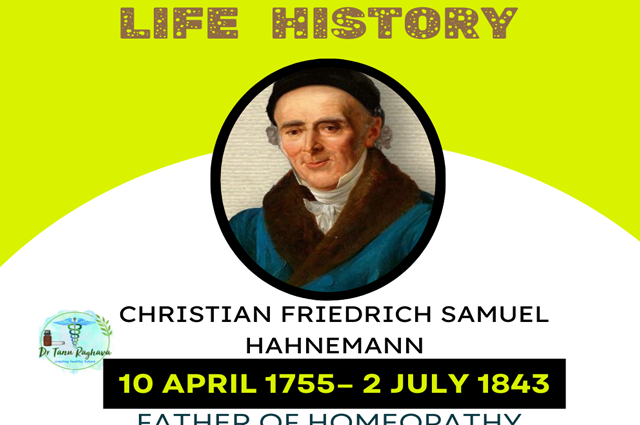INTRODUCTION
Dr. Samuel Hahnemann was a German doctor and the founder of Homeopathy. He introduced a natural and holistic way of healing, focusing on gentle treatments. Hahnemann’s dedication to finding better medical solutions led to the development of homeopathy, based on the idea that “like cures like.” This document describes his personal and professional life, and how he created homeopathy, with simple explanations and visuals.
Personal Life
EARLY LIFE
- Birth: Samuel Hahnemann was born on April 10, 1755, in Meissen, Saxony (modern-day Germany).
- Family: His father, Christian Gottfried Hahnemann, was a porcelain painter, and his mother, Johanna Christiana, influenced his upbringing.
- Education: Despite financial struggles, Hahnemann was an exceptional student, learning multiple languages like Greek, Latin, English, Italian, and Arabic.

MARRIAGE AND CHILDREN
In 1782, Hahnemann married Johanna Leopoldine Henriette Kuchler. They had eleven children together. Despite his demanding career, his family remained a source of support.

PERSONALITY AND HOBBIES
- Hahnemann was known for being curious, hardworking, and deeply compassionate toward his patients.
- He loved studying chemistry, plants, and languages, which greatly helped his medical research.
Professional Life
MEDICAL STUDIES AND EARLY PRACTICES
- Education: He studied medicine at the University of Leipzig and later at the University of Vienna. He completed his M.D. degree at the University of Erlangen in 1779.
- Early Career: Hahnemann practiced conventional medicine but was disappointed by the harmful effects of treatments like bloodletting and purging.
Discovering Homeopathy
In 1790, while translating William Cullen’s book on medicines, he questioned how cinchona bark worked against malaria. He experimented on himself and found that the bark caused malaria-like symptoms in healthy people. This led him to believe in the principle of “like cures like.”
CREATING HOMEOPATHY
Hahnemann’s discovery of homeopathy was met with resistance from the medical community, which was deeply entrenched in traditional practices. Yet, his success in treating patients with gentle, individualized remedies attracted a growing following. By 1810, he published The Organon of the Healing Art, a comprehensive guide to his revolutionary medical system. This work solidified his reputation as a pioneer and provided a framework for the practice of homeopathy worldwide.
The life history of Dr. Hahnemann reflects a relentless pursuit of a kinder and more effective form of medicine. His groundbreaking use of Cinchona bark demonstrated that healing need not rely on aggressive treatments but could harness the body’s natural ability to recover. His innovative approach, grounded in empirical observation and compassion, continues to inspire homeopathy practitioners and holistic medicine to this day.
In his later years, Hahnemann moved to Paris, where he practiced homeopathy until his passing in 1843. His legacy endures, reminding us of the transformative power of curiosity and the courage to challenge established norms for the betterment of humanity.
- Core Ideas: Hahnemann developed the main principles of homeopathy:
- Law of Similars: A substance that causes symptoms in a healthy person can cure similar symptoms in a sick person.
- Minimal Doses: Using very small amounts of medicine to treat illnesses, reducing side effects.
- Holistic Care: Treating the whole person, not just the disease.
- Organon of Medicine: In 1810, Hahnemann published this book explaining the philosophy and methods of homeopathy. It is still a key text for homeopathic practitioners.
HOW HOMEOPATHY EVOLVED?
Key Contributions
- Developed “potentization,” a method of diluting and shaking substances to increase their healing power while reducing harmful effects.
- Promoted individual treatments, customizing remedies to fit each patient’s needs.
Global Reach
- Homeopathy became popular in Europe, America, and India in the 19th century. Its gentle and effective treatments attracted many people.
- Inspired the creation of homeopathic schools and research centers worldwide.

Flowchart: Hahnemann’s Journey to Homeopathy
Born in Meissen (1755) –> Studied Medicine (1775-1779) –> Frustration with Conventional Medicine –> Experiment with Cinchona Bark (1790) –> Formulated Homeopathy Principles (1796) –> Published Organon of Medicine (1810) –> Overcame Challenges (1811-1835) –> Final Years in Paris (1835-1843)
The Story of Cinchona Bark by Dr. Samuel Hahnemann
Samuel Hahnemann, often revered as the founder of homeopathy, with an inquisitive mind and a profound desire to improve medicine, he embarked on a journey that would revolutionize healthcare. His life history is a testament to resilience, curiosity, and an unwavering dedication to the pursuit of knowledge.
After earning his medical degree in 1779, Hahnemann became increasingly disillusioned with the prevailing medical practices of his time. The methods were often harsh, relying on bloodletting, purgatives, and unproven remedies that frequently did more harm than good. Determined to find a better way, he turned to chemistry and pharmacology, fields where his expertise earned him a reputation as a skilled translator of medical texts.
It was during one of these translations, in 1790, that Hahnemann encountered a pivotal moment in the history of medicine. While translating Dr. William Cullen’s treatise on materia medica, he came across a description of Cinchona bark, a natural remedy used to treat malaria. Cullen attributed its efficacy to its “tonic properties,” but Hahnemann was skeptical. He decided to investigate the claim through experimentation, an approach rarely embraced at the time.
Hahnemann consumed a small dose of Cinchona bark himself :
Hahnemann consumed a small dose of Cinchona bark himself, meticulously observing its effects on his body. To his astonishment, he experienced symptoms remarkably similar to those of malaria: fever, chills, and sweating. This observation led him to hypothesize that Cinchona bark worked because it could produce symptoms in a healthy person similar to the disease it treated in a sick one.
This experiment marked the birth of the principle of similia similibus curentur, or “like cures like,” the cornerstone of homeopathy. Hahnemann expanded on this idea, conducting further experiments on himself and others. He tested various natural substances, carefully documenting their effects and identifying their therapeutic potential when diluted. This process became known as “proving,” a fundamental method in homeopathy.
HOMEOPATHY PRINCIPLES :
- Law of Similars: Like cures like.
- Illustration: Healthy person with symptoms and sick person treated by the same substance.
- Minimal Dose: Potentization process.
- Illustration: A substance being diluted step by step.
- Holistic Treatment: Treating mind, body, and emotions.
- Illustration: A person surrounded by symbols of health and balance.
Later Life
- In 1835, Hahnemann married Mélanie d’Hervilly, a French painter and homeopath. They moved to Paris and treated patients together.
- Hahnemann continued his work until his death on July 2, 1843, at the age of 88.
- Many traditional doctors and authorities opposed Hahnemann’s ideas. He had to move several times, including to Leipzig and Paris, to continue his work.
The FAQs about Dr. Samuel Hahnemann
Q 1. Who is Dr. Samuel Hahnemann?
Dr. Samuel Hahnemann was a German physician and chemist, recognized for founding the system of medicine known as homeopathy.
Q 2. When and where was Dr. Hahnemann born?
He was born on April 10, 1755, in the town of Meissen, located in Saxony, Germany.
Q 3. What led Dr. Hahnemann to develop homeopathy?
Disillusioned with the conventional medical practices of his era, he sought a safer and more effective treatment approach. His experiments with cinchona bark paved the way for the homeopathic principle of treating like with like.
Q 4. What is the main principle behind homeopathy?
The core philosophy of homeopathy is “like cures like,” meaning that substances causing certain symptoms in healthy people can help heal similar symptoms in sick individuals when used in small doses.
Q 5. Why is “The Organon of Medicine” significant?
“The Organon of Medicine” is Hahnemann’s key work, in which he detailed the theoretical and practical aspects of homeopathy. It remains an essential text in the field.
Q 6. What is the concept of potentization in homeopathy?
Potentization, introduced by Hahnemann, is a process of diluting and shaking a substance to enhance its healing properties while minimizing side effects.
Q 7. How did Hahnemann test his remedies?
He performed tests, known as “provings,” on healthy individuals to document the symptoms produced by specific substances, which helped establish guidelines for their therapeutic use.
Q 8. What difficulties did Hahnemann face while promoting homeopathy?
He encountered significant resistance and criticism from mainstream medical practitioners of his time, as they were skeptical of his innovative ideas.
Q 9. Where did Hahnemann spend his final years?
Dr. Hahnemann relocated to Paris during the later part of his life, where he continued his medical practice and refined homeopathic principles until his death in 1843.
Q 10. What is Dr. Hahnemann’s enduring influence?
Hahnemann’s pioneering work laid the foundation for homeopathy, which continues to be practiced globally as a holistic and individualized approach to healthcare.
Conclusion :
Dr. Samuel Hahnemann’s efforts to find better and safer treatments changed the world of medicine. His work led to homeopathy, a system of care that focuses on natural and personalized healing. Despite many challenges, his ideas gained global recognition and are still used today to help people live healthier lives.






1 Comment
Buy Traffic
November 25, 2025Wow! This can be one particular of the most helpful blogs We have ever arrive across on this subject. Basically Magnificent. I am also a specialist in this topic therefore I can understand your effort.